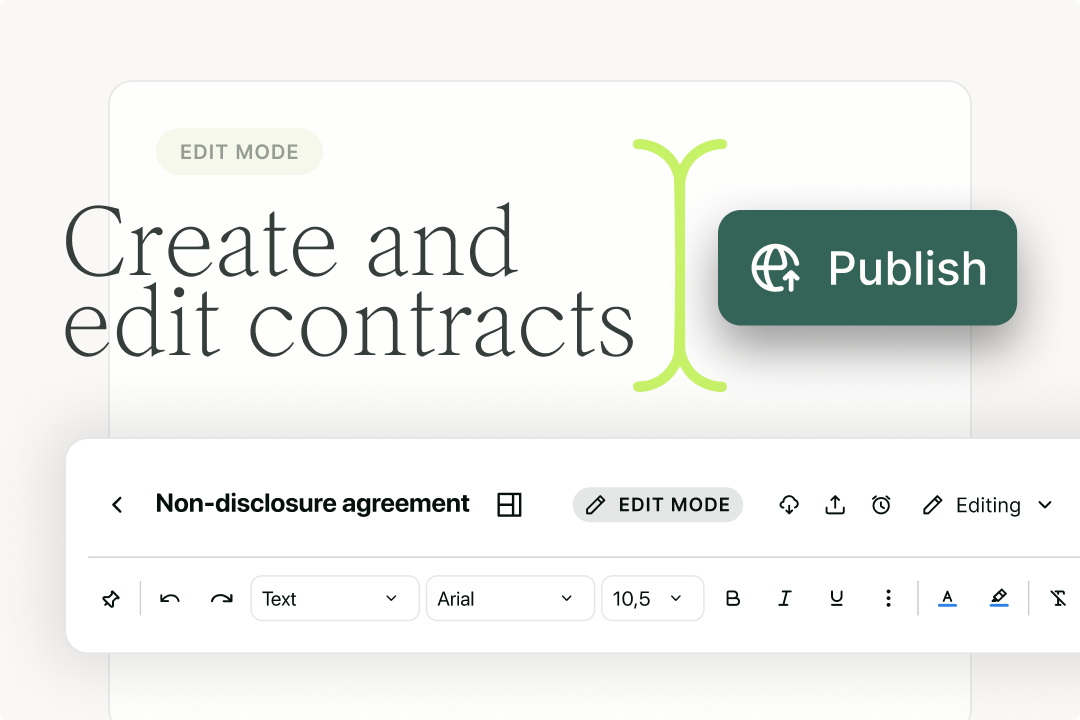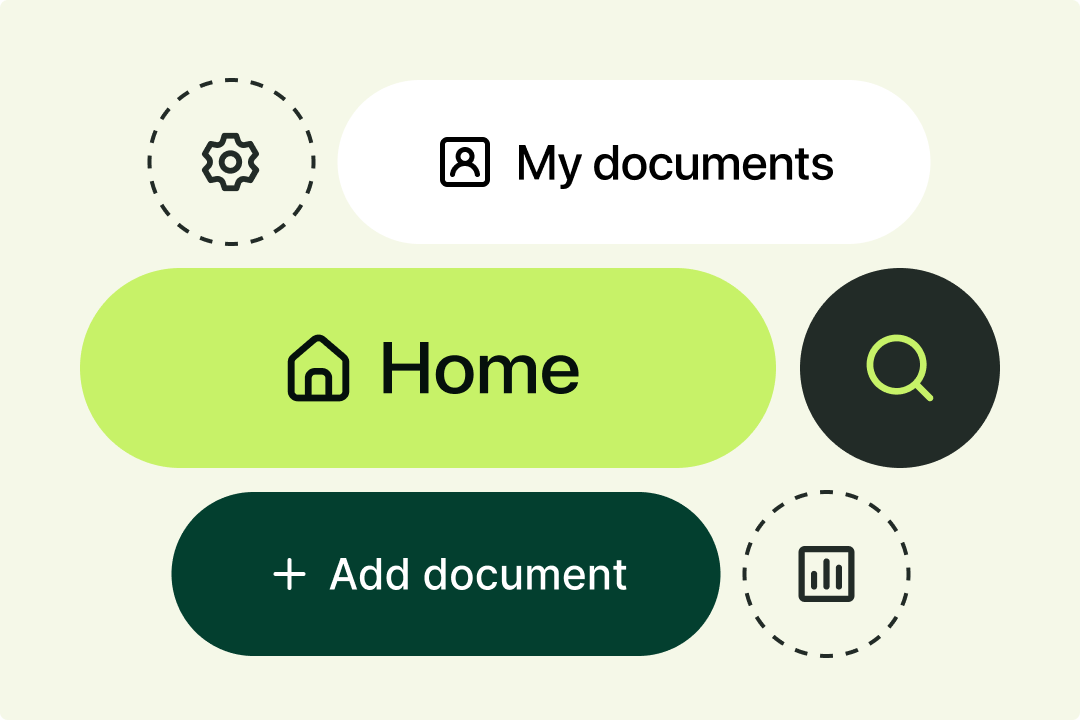Solutions
Customer Support
Resources
The business case for automation has never been stronger.
According to WorkMarket’s research,” 70 per cent of today’s business leaders admit that they spend from 10 to 40 per cent of their time performing mundane tasks like searching, modifying, and sending documents.
This is equivalent to spending anywhere from 45 minutes to three hours each day on tasks that aren’t essential to their primary role.
Document automation software offers businesses a chance to reverse this trend and focus on higher-value tasks. But what is document automation, how does it work, and should you invest in it? Let’s find out.
Document automation is the process of using software to generate electronic documents, without completing the manual tasks traditionally involved in document creation.
Formerly known as document assembly, document automation involves automating the admin tasks usually associated with creating routine documents.
This is achieved using software that populates documents with relevant information. This information is either extracted using a basic Q&A workflow or pulled into the template from another business platform via an integration.
By doing this, document automation workflows remove the need for legal and business teams to labour over drafting and populating documents manually. Instead, they can generate routine documents like business contracts at scale and in just a few clicks.
Document automation software is the technology businesses use to automatically generate documents, either individually or at scale.
Rather than legal and business teams drafting documents from scratch each time, document automation software uses automated templates to produce documents that are ready to use and share. This means that routine documents, like standard contracts, can be created on demand by the software, with no need for extensive administrative work.

Let’s explore how document automation software works in a bit more detail now.
Firstly, legal and business teams upload their document templates to their document automation tool. If the platform has a template editor, you may even choose to create them directly in the document automation software.
These templates include the boilerplate text you want all documents to use as standard. But they also have smartfields mapped out to tell the document automation software which information you want to populate within the template, and where.
Take an employment offer letter, for example. The offer letter template will include all of the standard clauses and terms that appear in every job offer letter, like the benefits offered by the company, the working hours, and so on. This is the boilerplate text.
But an offer letter will also need smartfields for any variable information, like the name of the candidate, their proposed salary, start date, etc. These smartfields act as containers for contract's metadata and are used by the document automation software to populate key fields within the document.

Depending on the document automation software you use, you may even be able to set more advanced rules in your templates.
For example, Juro users can set rules in their contracts so that the software automatically inserts or removes certain clauses when certain conditions are met. This could mean including an additional clause if a contract has a contract value over a certain threshold, or changing a term within a contract to suit different jurisdictions.
Like smartfields, these can be built into document templates to instruct the document automation software on what data needs to be included in a document and when. They can even be automated so that contracts are automatically routed to individuals for approval when they meet certain criteria.
Once you’ve set up your templates you’ll be able to generate documents individually and at scale. In a document automation tool like Juro, this is as simple as selecting a template and pressing create to get started.
What happens next will depend on which document automation software you use. When automating legal documents in Juro, you’ll have two options.
If you select this workflow, you’ll be asked a series of basic questions about the contract. Your answers to these questions will be the responses used to populate the document.
By integrating Juro with another platform, like your CRM, for example, you can pull relevant opportunity data directly into the contract. This is achieved by mapping certain smartfields in the document to data points within these other tools.
For example, you could integrate your tool with a CRM like Salesforce, Hubspot or Pipedrive and use the data within the CRM to populate an MSA. Or, you could integrate your document automation software with an ATS like Greenhouse and pull the data for an offer letter from there.
Not only do these integrations enable you to avoid manual data input, but they also enable other teams to generate documents from within these tools. This means that sales teams can automate documents in Salesforce, with no switching between tools.
You can also use document automation software to mass-generate documents, which is perfect for documents that need to be produced at scale.

Some document automation platforms will also offer functionality for managing documents beyond creation too.
For example, Juro offers the features businesses need to share, negotiate, sign, store and report on documents. This makes it a great solution for legal and business teams that want to automate admin tasks throughout a document’s lifecycle - not just during the creation stage.
To find out more about how Juro automates routine admin for your legal documents, hit the button below.
There are plenty of different use cases for document automation, with some businesses choosing to automate everything from invoices to receipts, quotes and reports.
However, one of the most predominant use cases for document automation is for contracts. Businesses, and particularly legal teams, typically set up contract workflows using document automation software to cover use cases that include:
These standard contracts are a great fit for document automation because businesses usually process high volumes of them, but the workflow involves little or no negotiation.
This means templated agreements can be created and pushed through to signature quickly, without too much back and forth or friction during the process.
Document automation is most useful for users who need to create routine documents at scale frequently. This is true regardless of their industry as all businesses rely on documents in some shape or form.
If you feel burdened by the extensive administrative work that goes into creating and sharing documents, document automation software is for you.
The biggest benefit of document automation software is that it enables legal and business teams to generate documents quickly with minimal time spent on admin.
Using document automation software enables teams to generate documents in just a few clicks. Without this software, teams can spend hours drafting documents manually, even if they follow the same template.
Tools like Juro enable users to generate documents in a faster and more efficient way. This makes it a great option for lean teams that need to avoid becoming buried in low-value admin and focus on higher priority projects.
“Before Juro, it would take legal up to two hours to draft a contract, longer if we had follow-up questions. Now sales can input information and legal can approve the contract - all in 20 minutes” - Alicja Kwiatkowski, Head of Legal, Iptor
Document automation software also results in more consistent documentation. This is because the templates used to automate documents have been pre-defined and pre-approved.
In other words, commercial teams have less free reign when it comes to drafting. This is particularly important for high-risk documents like commercial contracts where simple mistakes can result in costly claims and contractual disputes.
The smartfields used by document automation tools guide users through document population, control what they can edit, and ensure that documents are fully populated before being shared.
“Smart fields linked to the Q&A flow are a fantastic way to guide a user through populating the contract... It's simplified the contract generation process considerably” - Paul Harker, Head of Legal, Luno
We’ve talked about how document automation systems like Juro can increase efficiency. But let’s talk about what this means in terms of cost-savings.
By reducing the amount of admin required to create documents, you’re giving your team more time to work on the higher-value tasks they’ve been trained for. Not only does this mean that they can do more valuable work, but it also means you’re less likely to need an additional hire to manage the workload.
“There’s no greater ROI than the fact that by enabling our teams to self-serve, Juro reduced our need to hire a second lawyer” - Sophie Salisbury, Head of Legal, Appear Here
Document automation simplifies the process used to create documents, which enables less-experienced team members to self-serve on document creation.
This is particularly useful when it comes to legal documents which often require legal expertise to write and understand. Instead of waiting around for legal to draft a sales contract, sales teams can generate these documents in a few clicks. This means fewer blockers and less back and forth for legal and commercial teams.
Instead, document automation enables sales teams to generate their own contracts without increasing contractual risk.
This next benefit follows on from the last. Document automation software enables senior stakeholders to control what documents include and look like by pre-defining the templates they use.
In fact, systems like Juro enable template owners to lock templates and restrict edits, meaning they get the final say over documents without having to manually review each and every one.
Again, this is a crucial feature for lean legal teams that want to unblock commercial teams without increasing their risk appetite.
“Before Juro, we needed to review 100 per cent of customer contracts. Now that we can lock contract fields with Juro, that number has dropped to 12 per cent” - Victoria Sörving, CLO, Funnel
Document automation software is a fantastic way for businesses to scale their documents without scaling their headcount.
Since tools like Juro offer bulk actions, users are able to generate hundreds of contracts in one go, each with the correct data populated within them. This is particularly useful for fast-growing companies, or businesses that need to manage their onboarding documents more effectively.
Contracts have traditionally been agreed using a very manual process, with physical paperwork and wet ink signatures. However, document automation leads to the creation of online contracts, which can be reviewed, negotiated, agreed and signed from anywhere in the world.
This convenience, paired with the fact that legal documents are more personalized, will result in a better customer experience overall.
Unfortunately, when it comes to choosing a document automation system, there’s no ‘best’ option. After all, what one business needs from a document automation tool might differ from another.
However, it is possible to find one that’s perfect for you. If you’re in search of a tool to automate document creation and improve efficiency for your business, there are a few things to consider:
As organizations begin to manage more documents, they need solutions that reduce manual processing, lower costs and errors, increase compliance, and enhance employee satisfaction. Document automation technology can achieve all of these things.
Fill in the form below to find out more about how Juro’s document automation functionality can help your business generate legal documents faster, remove blockers, and get to value faster.
Lorem ipsum dolor sit amet, consectetur adipiscing elit. Suspendisse varius enim in eros elementum tristique. Duis cursus, mi quis viverra ornare, eros dolor interdum nulla, ut commodo diam libero vitae erat. Aenean faucibus nibh et justo cursus id rutrum lorem imperdiet. Nunc ut sem vitae risus tristique posuere.

